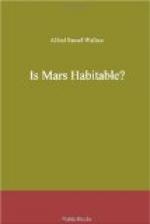Mr. Lowell is however so regardless of the ordinary teachings of meteorological science that he actually accounts for the supposed mild climate of the polar regions of Mars by the absence of water on its surface and in its atmosphere. He concludes his fifth chapter with the following words: “Could our earth but get rid of its oceans, we too might have temperate regions stretching to the poles.” Here he runs counter to two of the best-established laws of terrestrial climatology— the wonderful equalising effects of warm ocean-currents which are the chief agents in diminishing polar cold; the equally striking effects of warm moist winds derived from these oceans, and the great storehouse of heat we possess in our vapour-laden atmosphere, its vapour being primarily derived from these same oceans! But, in Mr. Lowell’s opinion, all our meteorologists are quite mistaken. Our oceans are our great drawbacks. Only get rid of them and we should enjoy the exquisite climate of Mars—with its absence of clouds and fog, of rain or rivers, and its delightful expanses of perennial deserts, varied towards the poles by a scanty snow-fall in winter, the melting of which might, with great care, supply us with the necessary moisture to grow wheat and cabbages for about one-tenth, or more likely one-hundredth, of our present population. I hope I may be excused for not treating such an argument seriously. The various considerations now advanced, especially those which show the enormous cumulative and conservative effect of our dense and water-laden atmosphere, and the disastrous effect—judging by the actual condition of the moon—which the loss of it would have upon our temperature, seem to me quite sufficient to demonstrate important errors in the data or fallacies in the complex mathematical argument by which Mr. Lowell has attempted to uphold his views as to the temperature and consequent climatic conditions of Mars. In concluding this portion of my discussion of the problem of Mars, I wish to call attention to the fact that my argument, founded upon a comparison of the physical conditions of the earth and moon with those of Mars, is dependent upon a small number of generally admitted scientific facts; while the conclusions drawn from those facts are simple and direct, requiring no mathematical knowledge to follow them, or to appreciate their weight and cogency. I claim for them, therefore, that they are in no degree speculative, but in their data and methods exclusively scientific. In the next chapter I will put forward a suggestion as to how the very curious markings upon the surface of Mars may possibly be interpreted, so as to be in harmony with the planet’s actual physical condition and its not improbable origin and past history.




